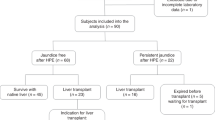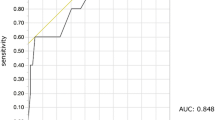Abstract
Purpose
The objective of this study was to determine the predictive index for prognosis in patients with biliary atresia (BA).
Methods
A total of 71 patients were divided into two groups. Group A included 39 postoperative BA patients who survived for more than 5 years with normal liver function and did not present cirrhosis, and group B included 32 patients who died from liver failure within 1 year after surgery. The clinical data of the two study groups were compared, and liver pathology was evaluated using a scoring system.
Results
The average age and weight were similar in the two groups (64.1 ± 16.8 days vs. 60.7 ± 19.3 days, p > 0.05; 4.9 ± 0.9 kg vs. 4.7 ± 0.8 kg, p > 0.05). There were no significant intergroup differences in preoperative total bilirubin (TB), direct bilirubin (DB), alanine transaminase, aspartate transaminase, and international normalized ratio. The preoperative levels of gamma-glutamyl transpeptidase (γ-GT) and albumin in group A were significantly higher than those in group B (γ-GT: 956.8 ± 503.8 IU/L vs. 620.2 ± 437.1 IU/L, p = 0.00; ALB: 40.8 ± 2.5 g/L vs. 36.8 ± 3.6 g/L, p = 0.04), whereas alkaline phosphatase was significantly lower in group A compared to group B (512.2 ± 224.6 IU/L vs. 631.7 ± 254.7 IU/L, p = 0.02). The postoperative TB and DB after 2 weeks of the Kasai procedure decreased significantly more in group A than in group B (TB: 53.9 vs. 21.4%, p = 0.00; DB: 51.0 vs. 22.7%, p = 0.00), whereas γ-GT increased significantly less in group A than in group B (48.3 vs. 142.1%, p = 0.00). Cystic structures were observed at the porta hepatis on ultrasound in more patients from group A (28.2 vs. 3.2%, p < 0.00). There was no significant difference in the total pathological score between the two groups (p = 0.38) whereas the score of bile plugs was significantly higher in group A (0.95 vs. 0.38, p = 0.03).
Conclusion
The cystic structures observed at the porta hepatis on ultrasound preoperatively and the rapid decrease in TB and DB within 2 weeks postoperatively predict good long-term prognosis, whereas a significant increase in γ-GT with a lower preoperative level predicts poor long-term prognosis. The development of bile plugs may be an indicator of favorable prognosis.

Similar content being viewed by others
References
Sokol RJ, Shepherd RW, Superina R et al (2007) Screening and outcomes in biliary atresia: summary of a National Institutes of Health workshop. Hepatology 46(2):566–581
Fischler B, Lamireau T (2014) Cholestasis in the newborn and infant. Clin Res Hepatol Gastroenterol 38(3):263–267
Jimenez-Rivera C, Jolin-Dahel KS, Fortinsky KJ et al (2013) International incidence and outcomes of biliary atresia. J Pediatr Gastroenterol Nutr 56(4):344–354
Feldman AG, Mack CL (2012) Biliary atresia: cellular dynamics and immune dysregulation. Semin Pediatr Surg 21(3):192–200
Baumann U, Ure B (2012) Biliary atresia. Clin Res Hepatol Gastroenterol 36(3):257–259
Davenport M (2012) Biliary atresia: clinical aspects. Semin Pediatr Surg 21(3):175–184
Chen G, Xue P, Zheng S et al (2015) A pathological scoring system in the diagnosis and judgment of prognosis of biliary atresia. J Pediatr Surg 50(12):2119–2123
Nio M, Wada M, Sasaki H et al (2015) Effects of age at Kasai portoenterostomy on the surgical outcome: a review of the literature. Surg Today 45(7):813–818
Nio M, Sasaki H, Wada M et al (2010) Impact of age at Kasai operation on short- and long-term outcomes of type III biliary atresia at a single institution. J Pediatr Surg 45(12):2361–2363
Goda T, Kawahara H, Kubota A et al (2013) The most reliable early predictors of outcome in patients with biliary atresia after Kasai’s operation. J Pediatr Surg 48(12):2373–2377
Koga H, Wada M, Nakamura H et al (2013) Factors influencing jaundice-free survival with the native liver in postportoenterostomy biliary atresia patients: results from a single institution. J Pediatr Surg 48(12):2368–2372
Baruah RR, Bhatnagar V, Agarwala S et al (2015) Correlation of pre- and post-operative liver function, duct diameter at porta hepatis, and portal fibrosis with surgical outcomes in biliary atresia. J Indian Assoc Pediatr Surg 20(4):184–188
Chung PH, Wong KK, Tam PK (2015) Predictors for failure after Kasai operation. J Pediatr Surg 50(2):293–296
Muthukanagarajan SJ, Karnan I, Srinivasan P et al (2016) Diagnostic and prognostic significance of various histopathological features in extrahepatic biliary atresia. J Clin Diagn Res 10(6):EC23-7
Serinet MO, Wildhaber BE, Broue P et al (2009) Impact of age at Kasai operation on its results in late childhood and adolescence: a rational basis for biliary atresia screening. Pediatrics 123(5):1280–1286
Sharad I, Wadhwani BA, Yumirle P et al (2008) Prolonged neonatal jaundice and the diagnosis of biliary atresia: a single-center analysis of trends in age at diagnosis and outcomes. Pediatrics 121(5): e1438–e1440
Rhu J, Jung SM, Choe YH et al (2012) PELD score and age as a prognostic index of biliary atresia patients undergoing Kasai portoenterostomy. Pediatr Surg Int 28(4):385–391
Wong KK, Chung PH, Chan IH et al (2010) Performing Kasai portoenterostomy beyond 60 days of life is not necessarily associated with a worse outcome. J Pediatr Gastroenterol Nutr 51(5):631–634
Chen G, Zheng S, Sun S et al (2012) Early surgical outcomes and pathological scoring values of older infants (≥ 90 d old) with biliary atresia. J Pediatr Surg 47(12):2184–2188
Chusilp S, Sookpotarom P, Tepmalai K et al (2016) Prognostic values of serum bilirubin at 7th day post-Kasai for survival with native livers in patients with biliary atresia. Pediatr Surg Int 32(10):927–931
Shneider BL, Magee JC, Karpen SJ et al (2016) Total serum bilirubin within 3 months of hepatoportoenterostomy predicts short-term outcomes in biliary atresia. J Pediatr 170:211–217
Rodeck B, Becker AC, Gratz KF et al (2007) Early predictors of success of Kasai operation in children with biliary atresia. Eur J Pediatr Surg 17(5):308–312
Koga H, Wada M, Nakamura H et al (2013) Factors influencing jaundice-free survival with the native liver in post-portoenterostomy biliary atresia patients: results from a single institution. J Pediatr Surg 48(12):2368–2372
Mukhopadhyay SG, Roy P, Chatterjee U et al (2014) A histopathological study of liver and biliary remnants in the long-term survivors (> 10 years) of cases of biliary atresia. Indian J Pathol Microbiol 57(3):380–385
Santos JL, Kieling CO, Meurer L et al (2009) The extent of biliary proliferation in liver biopsies from patients with biliary atresia at portoenterostomy is associated with the postoperative prognosis. J Pediatr Surg 44(4):695–701
Czubkowski P, Cielecka-Kuszyk J, Rurarz M et al (2015) The limited prognostic value of liver histology in children with biliary atresia. Ann Hepatol 14(6):902–909
Arii R, Koga H, Arakawa A et al (2011) How valuable is ductal plate malformation as a predictor of clinical course in postoperative biliary atresia patients? Pediatr Surg Int 27(3):275–277
Vuković J, Grizelj R, Bojanić K et al (2012) Ductal plate malformation in patients with biliary atresia. Eur J Pediatr 171(12):1799–1804
Longo-Santos LR, Teodoro WR, de Mello ES et al (2016) Early type I collagen deposition is associated with prognosis in biliary atresia. J Pediatr Surg 51(3):379–85
Mirza Q, Kvist N, Petersen BL (2009) Histologic features of the portal plate in extrahepatic biliary atresia and their impact on prognosis—a Danish study. J Pediatr Surg 44(7):1344–1348
Sanghai SR, Shah I, Bhatnagar S et al (2009) Incidence and prognostic factors associated with biliary atresia in western India. Ann Hepatol 8(2):120–122
Imanieh MH, Dehghani SM, Bagheri MH et al (2010) Triangular cord sign in detection of biliary atresia: is it a valuable sign? Dig Dis Sci 55(1):172–175
Roquete ML, Ferreira AR, Fagundes ED et al (2008) Accuracy of echogenic periportal enlargement image in ultrasonographic exams and histopathology in differential diagnosis of biliary atresia. J Pediatr (Rio J) 84(4):331–336
Kim WS, Cheon JE, Youn BJ et al (2007) Hepatic arterial diameter measured with US: adjunct for US diagnosis of biliary atresia. Radiology 245(2):549–555
El-Guindi MA, Sira MM, Sira AM et al (2014) Design and validation of a diagnostic score for biliary atresia. J Hepatol 61(1):116–123
Author information
Authors and Affiliations
Corresponding author
Ethics declarations
Conflict of interest
The authors declare that they have no conflict of interest.
Research involving human and animal participants
This article does not contain any studies with human participants or animals performed by any of the authors.
Rights and permissions
About this article
Cite this article
Sun, S., Zheng, S., Lu, X. et al. Clinical and pathological features of patients with biliary atresia who survived for more than 5 years with native liver. Pediatr Surg Int 34, 381–386 (2018). https://doi.org/10.1007/s00383-018-4231-7
Accepted:
Published:
Issue Date:
DOI: https://doi.org/10.1007/s00383-018-4231-7




